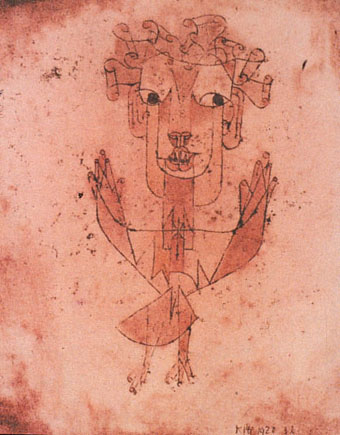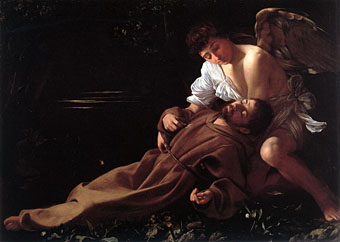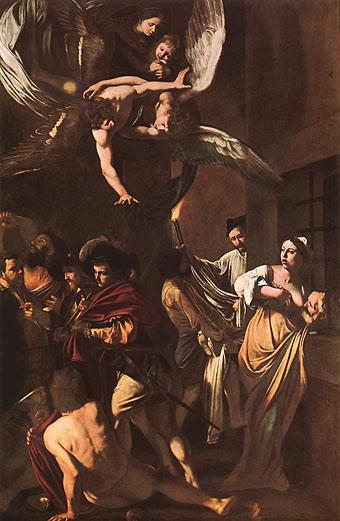Angelus Novus by Paul Klee (1920?).
The Catholic church failed to work its medieval magic on me beyond inspiring a fondness for ecclesiastic architecture and men with wings. But in keeping with the season it’s Angel Week here on { feuilleton } although some of the angels featured may not be quite Vatican-approved.
Above is the Paul Klee painting that prompted Walter Benjamin’s celebrated piece from ‘Theses on the Philosophy of History’ (1940) in Illuminations:
A Klee painting named Angelus Novus shows an angel looking as though he is about to move away from something he is fixedly contemplating. His eyes are staring, his mouth is open, his wings are spread. This is how one perceives the angel of history. His face is towards the past. Where we perceive a chain of events, he sees one catastrophe, which keeps piling wreckage upon wreckage and hurls it in front of his feet. The angel would like to stay, awaken the dead, and make whole what has been smashed. But a storm is blowing from Paradise; it has got caught in his wings with such violence that the angel can no longer close them. This storm irresistibly propels him into the future to which his back is turned, while the pile of debris before him grows skyward. This storm is what we call progress.
A world away from Benjamin’s wreckage, Caravaggio paints a typically luscious boy who just happens to have a pair of wings stuck to his back cradling a swooning saint in St Francis in Ecstasy. Ecstasy as a theme isn’t unknown in religious art, of course, but Renaissance painters usually showed St Theresa doing the fainting. Caravaggio was following a different muse.
St Francis in Ecstasy by Caravaggio (1595).
The pair of embracing angels tumbling into the marvellous Seven Acts of Mercy (below) are slightly more robust, a lot more so than the creature posing in Rest on the Flight to Egypt (1597), a picture whose precise religious content seems tenuous at best. And there are still those who believe Caravaggio’s interest in male flesh was solely artistic…
Seven Acts of Mercy by Caravaggio (1607).
More angels tomorrow.
Elsewhere on { feuilleton }
• The gay artists archive




What about your own fallen angel too?
http://www.johncoulthart.com/pantechnicon/fallenangel.html
PS I like all the little icons you’ve used as links for bibliopoesy etc etc.
Heh, “my” angel owes more to Jean Hippolyte Flandrin’s ‘Jeune homme assis au bord de la mer’ than my own imaginings. I merely added the wings.
http://www.artrenewal.org/asp/database/image.asp?id=16463
I just hope they cast the two gay angels properly in the film version of Phillip Pullman’s His Dark Materials Trilogy.
http://www.imdb.com/title/tt0385752/
although it looks like they’re just using voice talents from the above site so maybe the angels will be CGI creations.
I live in Rome, which is full of churches and angels, some of which strangely atypical.
Like this one : http://i67.photobucket.com/albums/h313/spacedlaw/Italy/SGAL.jpg
which dwells in the folds of San Giovanni a Laterano.
Ah Rome… Would love to go back there. My favourite angels were the Bernini ones on the Ponte Sant’Angelo.
http://en.wikipedia.org/wiki/Ponte_Sant'Angelo
As far as the Pullman films go, I’m looking forward to the turmoil that will no doubt ensue once the religious bigots get their knickers in a twist again. Still haven’t read the books.
There are also some very nice ones by Bernini in Sant’ Andrea delle Frate
http://i67.photobucket.com/albums/h313/spacedlaw/Italy/angel2.jpg
http://i67.photobucket.com/albums/h313/spacedlaw/Italy/angel1.jpg
They were supposed to go on the Ponte Sant’Angelo but were judged too lovely for such a fate.
I also like the old angel from the Castel Sant’Angelo – the new one is a tad too swashbuckly for my taste – it’s wings have delopped the loveliest of colors in the years:
http://i67.photobucket.com/albums/h313/spacedlaw/Italy/Angelodelcortile.jpg
Wow, don’t think I’ve seen these before, Angel 1 is tremendous. Bernini was quite an incredible artist.
One more reason to come back to Rome…